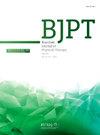The content of diagnostic information has an immediate effect on pain with loading in people with midportion Achilles tendinopathy: a randomized clinical experiment
IF 3.2
3区 医学
Q1 ORTHOPEDICS
引用次数: 0
Abstract
Background
Contemporary models of pain suggest the beliefs an individual holds regarding the cause of pain may influence pain intensity. Direct evidence supporting this idea is lacking in clinical populations.
Objective
Investigate if the content of diagnostic information about the cause of pain influences pain and function in people with Achilles tendinopathy.
Methods
Fifty recreational runners with Achilles tendinopathy participated in this randomised clinical experiment. Participants in the experimental group received an explanation of tendon pain that highlighted changes in muscle function as the primary problem, without reference to tendon pathology. Participants in the control group received an explanation of tendon pain that prioritised tendon pathology. The primary outcome measure was maximal pain intensity during a standardised hopping task measured on a 0–100 visual analogue scale. Secondary outcomes were lower limb stiffness while hopping and time in seconds for pain to ease upon completion of the hopping task.
Results
Pain intensity was lower in the experimental group post intervention (mean difference = 12.3 mm; 95 % CI: 3.2, 21.5). Lower limb stiffness was higher in the experimental group (mean difference = −1546 Nm−1; 95 % CI: −3296, 204) and time-to-ease was near identical (mean difference = 0 s; 95 % CI: −11, 11).
Conclusion
The content of diagnostic information influenced pain intensity with loading in people with Achilles tendinopathy. The effect on lower limb stiffness was uncertain and there appears to be no effect on time-to-ease.
诊断信息的内容对跟腱中段病变患者负重疼痛有直接影响:一项随机临床实验
当代疼痛模型表明,个体对疼痛原因的信念可能会影响疼痛强度。在临床人群中缺乏支持这一观点的直接证据。目的探讨跟腱病患者疼痛原因诊断信息的内容是否影响其疼痛和功能。方法对50例患有跟腱病的休闲跑步者进行随机临床试验。实验组的参与者接受了肌腱疼痛的解释,强调肌肉功能的变化是主要问题,而没有参考肌腱病理。对照组的参与者接受肌腱疼痛的解释,优先考虑肌腱病理。主要结果测量是标准化跳跃任务期间的最大疼痛强度,以0-100视觉模拟量表测量。次要结果是跳跃时下肢僵硬和完成跳跃任务后疼痛缓解的时间(以秒为单位)。结果实验组干预后牙周强度降低(平均差异12.3 mm;95% ci: 3.2, 21.5)。实验组下肢僵硬度较高(平均差值= - 1546 Nm - 1;95% CI: - 3296, 204),缓解时间几乎相同(平均差= 0 s;95% ci:−11,11)。结论诊断信息的内容影响跟腱病患者负重疼痛强度。对下肢僵硬的影响是不确定的,似乎对缓解时间没有影响。
本文章由计算机程序翻译,如有差异,请以英文原文为准。
求助全文
约1分钟内获得全文
求助全文
来源期刊
CiteScore
6.10
自引率
8.80%
发文量
53
审稿时长
74 days
期刊介绍:
The Brazilian Journal of Physical Therapy (BJPT) is the official publication of the Brazilian Society of Physical Therapy Research and Graduate Studies (ABRAPG-Ft). It publishes original research articles on topics related to the areas of physical therapy and rehabilitation sciences, including clinical, basic or applied studies on the assessment, prevention, and treatment of movement disorders.

 求助内容:
求助内容: 应助结果提醒方式:
应助结果提醒方式:


